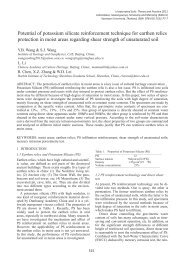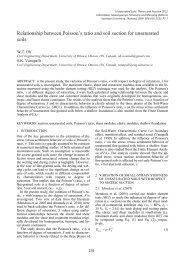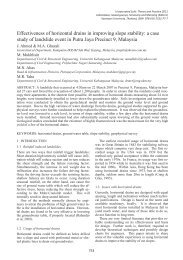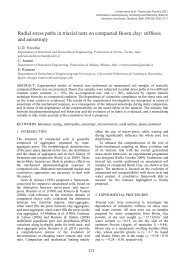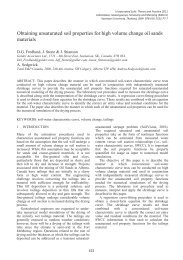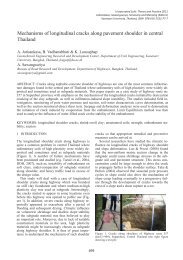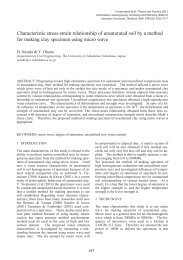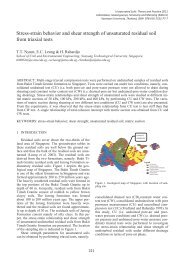Application of electrical resistivity method to detect deep cracks in ...
Application of electrical resistivity method to detect deep cracks in ...
Application of electrical resistivity method to detect deep cracks in ...
You also want an ePaper? Increase the reach of your titles
YUMPU automatically turns print PDFs into web optimized ePapers that Google loves.
Clay content <strong>in</strong> soil matrix also affects the soil <strong>resistivity</strong>.<br />
A mobile cloud <strong>of</strong> additional ions can be<br />
formed around each clay particle by the ion exchange<br />
property <strong>of</strong> clay. Due <strong>to</strong> these ions will facilitate<br />
easy flow <strong>of</strong> <strong>electrical</strong> current, <strong>electrical</strong> <strong>resistivity</strong><br />
<strong>in</strong> f<strong>in</strong>e gra<strong>in</strong>ed soils, such as clay, is always<br />
lower than expected (Zhdanov and Keller, 1994).<br />
As shown <strong>in</strong> Figure 3, there are some local zones<br />
with very low <strong>resistivity</strong> (3 – 30 m). The results <strong>of</strong><br />
borehole date confirmed that high porosity and high<br />
water content <strong>in</strong> these zones (The ERT test was undertaken<br />
<strong>in</strong> ra<strong>in</strong>y season). Therefore, these zones<br />
could be identified as possible locations for <strong>cracks</strong>.<br />
Soil crack zones have very high porosity and high<br />
water content <strong>in</strong> ra<strong>in</strong>y season as ra<strong>in</strong> water can easily<br />
seeps <strong>in</strong><strong>to</strong> <strong>cracks</strong>. This hypothesis was justified <strong>in</strong><br />
pr<strong>of</strong>ile l<strong>in</strong>e 1 (Figure 3(a)) as the visible surface<br />
crack co<strong>in</strong>cides with the very low <strong>resistivity</strong> zone <strong>in</strong><br />
the subsoil. However, it was unable <strong>to</strong> perform <strong>resistivity</strong><br />
test <strong>in</strong> the vic<strong>in</strong>ity <strong>of</strong> the surface crack <strong>in</strong> pr<strong>of</strong>ile<br />
l<strong>in</strong>e 2 and 3 due <strong>to</strong> the accessibility issues <strong>in</strong> the<br />
area.<br />
The low <strong>resistivity</strong> zones, which can be observed<br />
at the horizontal distance (from A) between 60 m <strong>to</strong><br />
130 m and at the depth from 0 <strong>to</strong> 12 m, are consistence<br />
<strong>in</strong> all three pr<strong>of</strong>iles. This will suggest the possible<br />
transverse <strong>cracks</strong> <strong>in</strong> this area.<br />
3.2 Azimuthal <strong>method</strong><br />
To obta<strong>in</strong> a more detail identification <strong>of</strong> the <strong>deep</strong><br />
<strong>cracks</strong> <strong>in</strong> subsoils, an azimuthal <strong>resistivity</strong> technique<br />
(ART) was carried out <strong>in</strong> the possible soil <strong>cracks</strong><br />
zone. As shown <strong>in</strong> Figure 1 and Figure 3 (a), there<br />
are two locations for the ART. They are: the middle<br />
<strong>of</strong> Pr<strong>of</strong>ile L<strong>in</strong>e 1 (A1 location) and the nearby location<br />
<strong>of</strong> the visible surface crack (A2 location).<br />
In general, the nature <strong>of</strong> anisotropy can be seen<br />
from the existence <strong>of</strong> <strong>cracks</strong> <strong>in</strong> a layer <strong>of</strong> soil. Azimuthal<br />
<strong>resistivity</strong> technique can be used <strong>to</strong> determ<strong>in</strong>e<br />
the direction <strong>of</strong> vertical <strong>cracks</strong> <strong>in</strong> the soil (Senos-matias,<br />
2002; Busby & Jackson, 2006 and<br />
Schmutz et al., 2006). A square arrays configuration<br />
was selected <strong>to</strong> be used <strong>in</strong> this study <strong>to</strong> <strong>in</strong>dicate the<br />
existence <strong>of</strong> anisotropy <strong>of</strong> the medium. This <strong>method</strong><br />
will characterize the soil crack by us<strong>in</strong>g m<strong>in</strong>or <strong>resistivity</strong><br />
that <strong>in</strong>dicates the angle direction <strong>of</strong> soil crack<br />
and the <strong>in</strong>fluential depth <strong>of</strong> the crack zones. An <strong>in</strong>cremental<br />
array size (a) from 2m <strong>to</strong> 12m will be<br />
used. The depth <strong>of</strong> soil crack (D) will be determ<strong>in</strong>ed<br />
us<strong>in</strong>g this equation below:<br />
From the results <strong>of</strong> ART <strong>in</strong> the selected locations<br />
as shown <strong>in</strong> Figure 4, it was found that:<br />
(a) A1 location results (b) A2 location results<br />
Figure 4. Result <strong>of</strong> Azimuthal Resistivity Technique<br />
At location A1, <strong>cracks</strong> <strong>in</strong> soil were <strong>detect</strong>ed <strong>in</strong> a<br />
direction <strong>of</strong> 135 ° from the north, 0 <strong>to</strong> 5.65 m<br />
<strong>deep</strong>.<br />
At location A2, a non l<strong>in</strong>ear crack direction is<br />
found. From surface <strong>to</strong> a depth <strong>of</strong> 1.41 m, the<br />
crack beg<strong>in</strong>s at an angle <strong>of</strong> 165 from the North<br />
(N 165 E). From the depth <strong>of</strong> 1.41 m <strong>to</strong> 4.24 m,<br />
direction <strong>of</strong> the crack changed <strong>to</strong> an angle <strong>of</strong><br />
180 from the North (N 180 E). Then from the<br />
depth <strong>of</strong> 4.24 m <strong>to</strong> 5.65 m, the crack direction<br />
lies between 180-195 angles from the North<br />
(N 180-195 E).<br />
The results <strong>of</strong> the ART conducted at A2 will confirm<br />
the existence <strong>of</strong> the crack that is visible on the<br />
surface (Figure 1). The results <strong>of</strong> dipole-dipole and<br />
ART at A1 are consistence and that will suggest a<br />
possible crack at this location.<br />
4 DISCUSSION ON SOIL RESISITIVITY AND<br />
GEOTECHNICAL DATA<br />
In this study, the geotechnical <strong>in</strong>vestigation (SPT<br />
and soil sampl<strong>in</strong>g) was carried out <strong>in</strong> the study area<br />
<strong>in</strong> order <strong>to</strong> verify the subsurface <strong>cracks</strong> <strong>detect</strong>ed us<strong>in</strong>g<br />
the ERT result. Further, the results <strong>of</strong> geotechnical<br />
<strong>in</strong>vestigation and ERT can be used <strong>to</strong> develop<br />
useful correlations that can predict soil parameters<br />
from the soil <strong>resistivity</strong> data.<br />
904



